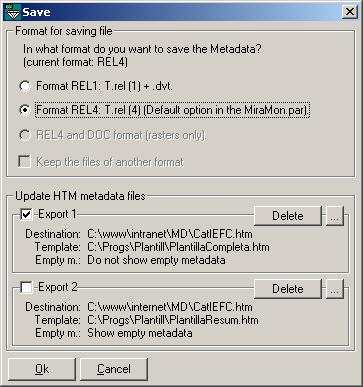METADATA EXPORT FROM GeM+
The Universal Geospatial Metadata Manager allows the export in an HTML format file of information about metadata and the relations in a MiraMon database. HTML is an appropriate format since it can be used to publish metadata directly in Internet or on an Intranet and it can also be used for copying into text reports (given that most word processors are able to read HTML format). In order to allow the user to select what information they wish to show and how best to show it, the Manager uses a template as the basis for constructing the HTML document. Therefore, to define a metadata export it is necessary to decide the name of the resulting HTML file and to select the name of the template to be used.
The Manager offers two routes for generating HTML metadata files.
1. Automatic export
The HTML metadata file can be updated each time the layer's metadata are saved. In order to perform automatic updates it is necessary to define metadata files to be generated and also the templates from which they must be generated. This information is stored within the metadata layers themselves such that, when metadata are saved from the Universal Geospatial Metadata Manager the HTML file is automatically updated. (This is ideal for maintaining a permanently updated web).
The following figure shows the appearance of the box that allows to define the HTML metadata files that will be generated when the file is saved :

It is possible to save the name and the characteristics of two metadata exports. There are tools for deleting or editing (button "...") The "Delete" button allows the characteristics of each defined export to be deleted one by one whilst the "..." button allows them to be edited. For each Export the following are defined:
- Ouptut: The name and path of the resulting HTML file
- Template: The name and path of the HTML metadata template to use. This template is also in HTML format and defines the metadata that will be shown for each layer. The template can also contain any text, image etc. as desired. The program provides two basic metadata templates and the user may use these to build other templates with suitable appearance and contents. For more information on the structure of the templates consult Generation of export templates.
- M. empty: it is possible that the user wishes to show all the metadata contained in the template or only those metadata in the template that actually have some value.
It is not always necessary to generate all the defined export metadata. The [V] box permits the user to decide which defined exports are generated when metadata are saved. In the above example, when the metadata are saved an HTML metadata intranet file will be generated or updated (Export 1) and not an HTML metadata file for internet (Export 2). It is also saved in the metadata, for each export, if the last time that the defined metadata HTML file was generated, to simplify the management of the HTML pages.
2. Occassional Export
In the Views tag the "Export" button (in the upper part of the tag) allows the HTML format export characteristics to be defined and generates a specific file for this operation. This information is not saved in the metadata and, therefore, the next time the metadata are consulted it will be necessary to define it again. This tool is useful for generating a specific export that will not typically be repeated in future.